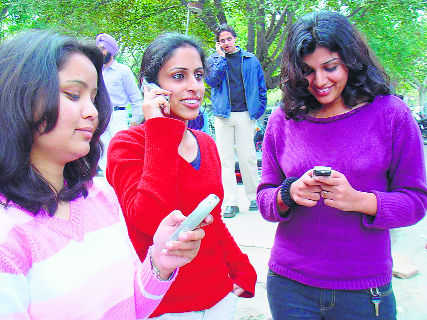
Phubbing: When a person snubs another by concentrating on the phone.
Rajesh Gill
Professor, Department of Sociology, Panjab University
So much has been said and written about the youth in Punjab in recent times. That something is terribly wrong with the youth in this state, which was known for its robust and strong men and women, is no secret. A large number of our boys are hooked to drugs and alcohol, both in villages and cities; and the state has a very high incidence of HIV-AIDS cases. It is an open secret that it is easier to get drugs and alcohol than food in Punjab, thanks to the innumerable liquor shops, flocked by men, young and old, in the evenings, when their families are waiting for them at home.
The state has shown a dismal academic performance of its government-run schools in terms of pass percentage over the past few years. There has been a substantial increase in drug-related deaths in Punjab. According to the official statistics, there were 60 deaths between January and June 2018 due to overdose of drugs in Punjab. In a study conducted by AIIMS, New Delhi, there were two lakh drug addicts in the state in 2015.
While the youth of Punjab are trapped in the web of drugs and alcohol, the incumbent government announced that it would provide smartphones to three lakh youth (initially the figure was 50 lakh) on the production of a certification stating that the individual did not already have a smartphone.
The smartphone combines telephone and computer services in one device, offering standard telephony through a cellular network as well as Internet services, manageable through WiFi connections or 3G/4G services provided through the cellular data networks.
The objective behind providing smartphones to Punjab’s youth, as conceived by the government, is to enhance their digital access and avenues of education and employment, skill enhancement and basic citizen-centric services through government applications. The Punjab Government, therefore, decided to distribute smartphones among the students graduating from government schools and colleges in the state.
No doubt, there are numerous advantages of digital technology, particularly in terms of connectivity at the global level and accessing information of all sorts; there are online courses in which the youth can enrol themselves, apart from benefiting from various welfare schemes of the government etc.
But the ground reality is startling. The project appears to rest upon the presumption that the youth would use smartphones for education, career-building and knowledge-seeking. However, as indicated by research on the subject, such a measure has the potential of pushing the youth in Punjab into another form of addiction — Internet addiction — with enormous implications on their physical and mental health.
Internet addiction, as reported by various studies, has exposed the youth, all over the world, to grave risks of cybercrime, financial and other frauds, pornography, cyber-bullying, sleep deprivation, exposure to unsuitable digital content, low social interaction and breakdown of face-to-face encounters.
It is always wise to learn from the experiences of societies already in the grip of digital technology, ruling the lives of their citizens, especially the youth. It was found in a study conducted in Korea in 2015 that the rate of Internet addiction was the highest among adolescents up to the age of 19. The study found that addiction to smartphone significantly affected emotional intelligence among the youth, thus causing severe consequences for the social health of society as a whole, and the youth in particular.
It is a common sight to find friends sitting together, each one busy with his/her smartphone, with absolutely no interaction with one another. I have often come across couples on an outing, in a restaurant, preoccupied on their smartphones, completely oblivious of each other. I was astounded once to see an adolescent riding a two-wheeler, who made it a point to take out his smartphone from his pocked at every red light and check it quickly, before the light turned green. Every message on WhatsApp or Facebook is so important for the young boys and girls that they can miss everything but not this.
Studies have been conducted the world over on the phenomenon of ‘phubbing’, wherein a person snubs another person/s in a social setting by concentrating on a smart phone, thus blocking all communication with people around. Research has also indicated that very few among the youth use internet for learning, and these are primarily used for entertainment and messaging. In a study conducted in 36 colleges located in Uttar Pradesh, expensive smartphones were the frequently used device for phubbing, mainly carried through WhatsApp. Smartphone use was also found to disrupt leisure-time physical activity, promote sedentary behaviour and social isolation.
In another study conducted in Tanzania in 2015, a majority of young students were reported to be spending five to seven hours per day on smartphone, which eventually affects their academic performance, since the time supposed to be spent on studies, is spent on Facebook, Twitter, Snapchat, WhatsApp and other social networking sites. Students admitted that they always responded on these sites even during the classes and they just could not survive without the smartphone even for a single day. There was hardly any student who used the smartphone for academic purpose. In this study, female students were found to be even more addicted to smartphones.
Given this background, the question is, can we really afford pushing our youth passing out of government schools and colleges into a state of physical and mental isolation from their parents, siblings, teachers and even their friends, at a time when they need to channel all their energy and time into acquiring skills to sustain in a world exuding cut-throat competition? Punjab has already gone through an unfortunate phase wherein its strong, hardworking, agile and healthy youth have gone meek, lazy, distressed, physically unfit and mentally confused.
What we need is an environment in schools and colleges, apart from society in general, which guarantees best opportunities to our sons and daughters to excel in academics, sports, music, science, literature, business, management and politics.
The cash-strapped Punjab has many other areas which are gasping for investment, particularly quality education, more teachers in schools, colleges and universities and employment generation; and the money needs to be pumped into these, instead of wasting it on smartphones for the impressionistic souls who cannot afford to waste their time in the virtual and deceptive world. Let us not mix politics with the future of our children, lest we are unable to face our next generation. The responsibility of pulling them out of their cocoons, making them learn the importance of hard work, honesty, excellence and nation-building lies with each one of us as parents, teachers, politicians and the government.



























